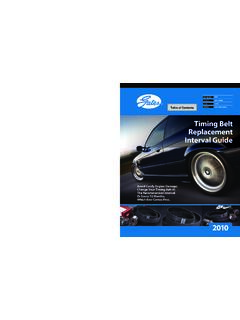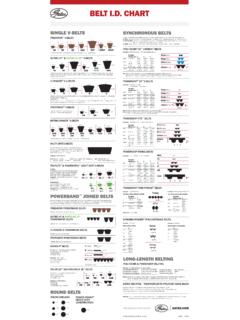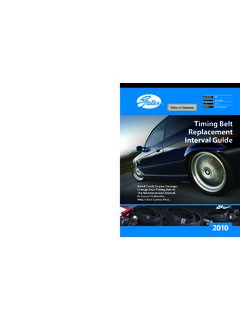Transcription of DRIVE DESIGN MANUAL - Gates Corporation
1 DRIVE DESIGN MANUAL DESIGN your drives online at O L Y CHAIN GT C ARBON B elt DRIVE Systems #17595 5/12 World HeadquartersGates Corporation1551 Wewatta StreetDenver, Colorado 80202 Tel: ExportsGates In terAmericaTel: 954-926-4568 Fax: ApplicationEngineersTel: PAGE Safety Policy .. 1 DRIVE Surve y SheetsLow-Speed DRIVE DESIGN Load Calculations and Information Sheet .. 4-7 High-Speed DRIVE Survey and Energy Savings Worksheet .. 8 Gates DESIGN IQ Data Worksheet .. 9 Poly Chain GT Carbon Belt DrivesBelt System S pecifications.. 2 Gates Poly Chain GT Carbon Belt Standard Line .. 3 Standard Belt DRIVE Selection Pr ocedure .. 10-13 NEMA Minimum S procket Diameters .. 14 Poly Chain GT Carbon Belt Service Factors .. 15 Pol y Chain GT Carbon Belt DRIVE Se lection Tables8mm Pitch Belts .. 16-3114mm Pitch Belts .. 32-45 Poly Chain GT Carb on Belt Power Rating Tables8mm Pitch Belts.
2 46-5314mm Pitch Belts .. 54-63 Poly Chain GT 2 Sprocket SpecificationsSprocket Reference Drawings.. 648mm Pitch S procket Dimension Tabl es .. 65-6814mm Pitch S procket Dimension Tabl es ..69-73 Sprocket S pecifications .. 74 Bored-To-Size S procket Bore Range Listing.. 75 Bored-To-Size S procket Re-bore Specifications and Instructions .. 76 Taper-Lock BushingsDrawings and Dimension Tabl es .. 77 Stock Bore and Keyseat Information .. 78-79 Taper-Lock Type S procket Install ation and Removal .. 80 Belt DRIVE Tensioners .. 81-82 Poly Chain GT2 Sprocket Diameter TablesLong-Length Belting8mm Pitch Tabl e .. 83-8414mm Pitch Table .. 84-85 IntroductionDrive SelectionClamping Fixtures.. 86.. 87.. 87 DESCRIPTION PAGE Short-Length 8mm Pitch Pol y Chain GT Belt DrivesIn troduction .. 88 Belt System Specifications.. 89 Stock Belt Lengths and Widths..908mm Pitch Belt DRIVE Selection Tabl es.
3 90-93 Engineering Data Section I Application DESIGN Considerations1. Gear Motors/Speed Reducer Drives .. 94-952. Electr ic Motor Frame Dimensions .. 953. Minimum Recommended Sprocket Diameters for General Purpose Electric Motors .. 964. High Driven Inertia Drives .. 965. Air Moving Drives ..96-976. Linear Motion Drives ..977. High Performance Vehicle Applications ..978. Belt DRIVE Registration .. 979. Belt DRIVE Noise ..9810. Use of Flanged S prockets ..9811. Fixed (non-a djustabl e) Center Distance ..98-9912. Use of Idlers ..9913. Specifying Shaft Locations in Multipoint DRIVE Lay outs ..99-10014. Minimum Belt Wrap and Tooth Engagement .. 10015. Adverse Operating Environments .. 100 Section II Engineering DESIGN Considerations1. Belt Storage and Handling.. 1012. Center Distance and Belt Length .. 1013. Belt Tooth Pr of iles .. 1014. Static Conductivity .. 1025.
4 Sprocket Diameter and Speed .. 1026. Efficiency .. 1027. Belt Tol erances .. 1038. Belt Install ation Tension .. 103-1049. Center Distance All owances for Install ation and Tensioning .. 10510. DRIVE Alignment .. 105-10611. Belt Install ation.. 10612. Belt Pull Calculations.. 10613. Bearing/Shaft Load Cal culations.. 106-10714. Self-Generated Tension .. 107 Technical DataTroubl eshooting .. 108-109 Standard Calculations .. 110 Useful Formulas and Calcula tions .. 111-112 Synchronous Belt Pr oduct DESIGN Catalogs .. 113 Tab le of ContentsSynchronous belts are being used more extensively than ever before in the industry where synchronization of one shaft speed to another is of primary importance. Gates Corporation has prepared this complete Poly Chain GT Carbon Belt DRIVE DESIGN MANUAL to handle these ex-acting applications. Poly Chain drives also eliminate maintenance and noise problems associated with chain drives and reduce maintenance required on other problem power transmission drives.
5 Stock Belt Drives are presented in this MANUAL for your convenience. If your DRIVE requirements (Speed, Ratio, Center Distance, Space, Horsepower) are not met, contact your local Gates 2009 Gates CorporationDenver, Colorado 80202 Printed in rewordSAFETY POLICYWARNING!Be Safe! Gates belt DRIVE systems ar e very reliable when usedsafely and within Gates application recommendations. However, there ar especific USES THAT MUST BE AVOIDEDdue to the risk of seriousinjury or death. These pr ohibited misuses include:Primary In-Flight Aircraft SystemsDo not use Gates belts, pulleys or sprockets on air craft, pr opeller or rotordrive systems or in-flight accessory drives. Gates belt DRIVE systems ar enot intended for air craft SystemsDo not use Gates belts, pulleys or sprockets in applications that dependsolely upon the belt to slow or stop a mass, or to act as a brake withoutan independent safety backup system.
6 Gates belt DRIVE systems are notintended to function as a braking device in emergency stop Driving Force in Power DRIVE DESIGN SOFTWARED rive DESIGN software can be found This software assi sts designers in quicklyse lec ting optimum DRIVE CorporationTo satisfy a wide range of loads, speeds and applications, Poly Chain GTCarbon belts and sprockets are made in a selection of sizes, capacitiesand three principal dimensions of a belt are:ppiittcchh ppiittcchh lleennggtthh wwiiddtthhBelt pitch is the distance in millimeters between two adjacent tooth centersas measured on the pitch line of the belt. Belt pitch length is the total length(circumference) in millimeters as measured along the pitch line. The theoret-ical pitch line of a Poly Chain GT Carbon belt lies within the tensile three principal dimensions of a sprocket are:ppiittcchh nnuummbbeerr ooff sspprroocckkeett ggrroooovveess wwiiddtthhOn the sprocket, pitch is the distance between groove centers and is meas-ured on the sprocket s pitch circle.
7 See illustration at right. The pitch circleof the sprocket coincides with the pitch line of the belt mating with it. Thesprocket s pitch diameter is always greater than its outside Poly Chain GT Carbon belt must be run with Poly Chain GT2 sprock-ets of the same Poly Chain GT Carbon belts are made in 8mm and 14mm belt sizes are listed in the stock Poly Chain GT Carbon BeltTables on page 3. Specifications for the 8mm and 14mm pitch belts list thebelt pitch lengths, number of teeth, stock widths and appropriate the information from these tables, a code for ordering a specific beltcan be determined as shown in the following examples:Sprockets for Poly Chain GT Carbon belts are also made in 8mm and14mm pitches. Standard sprocket sizes are listed in the SprocketSpecification Tables on Pages 64 through 74. For each Poly Chain GTCarbon belt width, there is a table listing the sprocket code symbol, theapplicable bushing style and pertinent dimensional information.
8 Thesprocket code symbol components are determined by using the followingexamples:*The S is used after the number of grooves to help identify it is a sprock-et and avoid any confusion with the belt bushing style to be used with a specific sprocket is listed in theSprocket Specifications Tables. Reference to the Stock Bushings for PolyChain GT2 plus Bore and Keyseat information will give you the data need-ed to order the proper bushing. For example,SSttyyllee 22551177 BBuusshhiinngg wwiitthh aa 22--iinncchh GGaatteess PPoollyy CChhaaiinn GGTT CCaarrbboonn BBeelltt SSyysstteemm SSppeecciiffiiccaattiioonnssBBeellttBBee llttBBeellttPPiittcchhPPiittcchh LLeennggtthhWWiiddtthh((mmmm))((mmmm))(( mmmm))8 MGT6401214 MGT119037 PPiittcchhSSpprroocckkeett DDeessiiggnnaattiioonnWWiiddtthh((mmmm)) && GGrroooovveess((mmmm))8MX48S*1214MX36S*3 7 The Driving Force in Power GGaatteess PPoollyy CChhaaiinn GGTT CCaarrbboonn BBeelltt SSttaannddaarrdd LLiinneeSSttoocckk SSiizzeess88mmmm WWiiddtthhss1122mmmm 2211mmmm3366mmmm 6622mmmm (.)
9 47 in.)(.83 in.)( in.)( in.)LLoonngg LLeennggtthh PPoollyy CChhaaiinn GGTT22 BBeellttiinngg SSttoocckk WWiiddtthhss88mmmm PPiittcchh WWiiddtthhss1144mmmm PPiittcchh WWiiddtthhss1122mmmm2211mmmm3366mmmm2200 mmmm3377mmmmSpecial widths available upon WWiiddtthhss2200mmmm3377mmmm6688mmmm 9900mmmm 112255mmmm (.79 in.)( in.)( in.)( in.)( in.)Dimensions are given in inches and millimeters. Inches are shown in black type. Millimeters are shown in PPiittcchh PPiittcchh When designing Poly Chain GT Carbon belt drives to be used in low-speedapplications (generally 500 rpm and less), traditional DRIVE DESIGN proceduresmay yield drives with greater-than-needed capacity. These DESIGN load cal-culations are intended primarily for applications on the output side of gearreducers, and will yield Poly Chain GT Carbon belt drives competitive in bothcost and performance with roller chain and superior to other belt recent power transmission industry publication estimated that half of motors operate at less than 60 percent of their rated load and one thirdoperate at below 50 percent of their rated load.
10 Significant power losses canalso occur in speed reducers, further reducing the actual torque loads car-ried by belt order to prevent over sizing belt drives for these low speed applications,the DESIGN should be based upon the actual system running load. Becausethe actual running load may or may not be known, the following threeapproaches are recommended to assist the designer in determining theappropriate DESIGN load:PPoollyy CChhaaiinn GGTT CCaarrbboonn LLooww--SSppeeeedd DDeessiiggnn LLooaadd CCaallccuullaattiioonnssFFoorr uussee wwhheenn ddeessiiggnniinngg PPoollyy CChhaaiinn GGTT CCaarrbboonn bbeelltt ddrriivveess ffoorr ggeeaarr rreedduucceerr oouuttppuutt sshhaaffttss aanndd ggeenneerraall rroolllleerr cchhaaiinn AAccttuuaall OOppeerraattiinngg LLooaaddss KKnnoowwnnIn those cases where the actual operating load is known, DESIGN the beltdrive for the actual operating load rather than for a load based upon themotor name plate.






